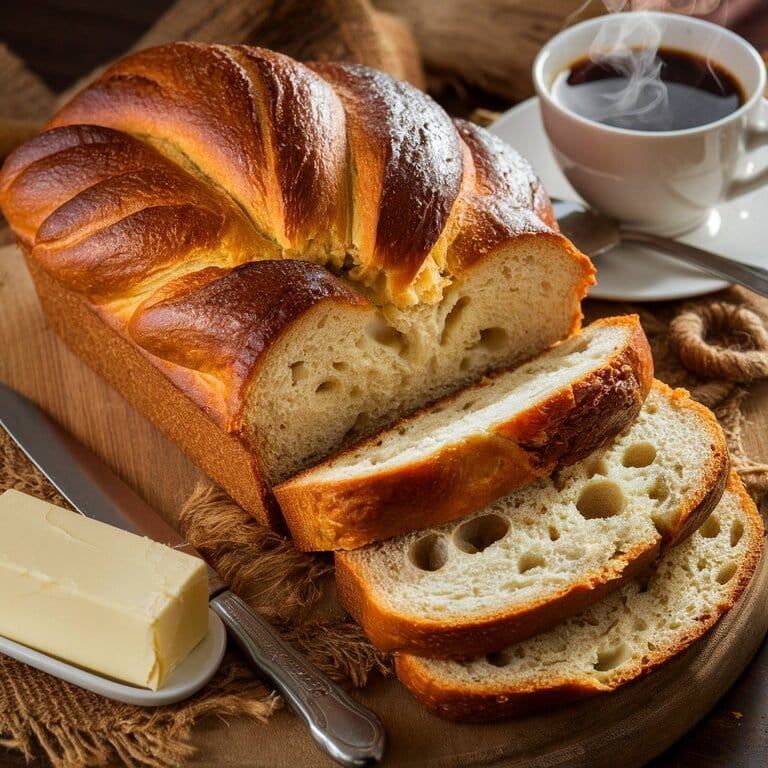Sourdough Discard Brioche: A Rich and Buttery Bread
There’s something undeniably magical about transforming kitchen scraps into something spectacular. For bakers, sourdough discard often feels like culinary gold an ingredient that bridges the gap between waste and wonder. Enter Sourdough Discard Brioche, a rich and buttery bread that combines the tangy complexity of sourdough with the airy, tender crumb of a classic brioche. This is not just a bread; it’s a testament to the art of mindful baking, where nothing goes to waste, and every ingredient finds its place in the spotlight. If you’ve ever felt guilty about tossing out sourdough starter, this recipe is your redemption a way to elevate the humble discard into a loaf that is as luxurious as it is practical.
Good bread is the most fundamentally satisfying of all foods; and good bread with fresh butter, the greatest of feasts.
James Beard
Imagine a bread that’s buttery, with just the right amount of sweetness, and the unmistakable depth of flavor that only sourdough can provide. Whether you’re a seasoned baker looking to explore new territories or a novice eager to impress, this Sourdough Discard Brioche is a perfect adventure. It’s a bread that begs to be shared, torn apart with friends over coffee or used to elevate your breakfast game to gourmet levels. With this recipe, you’ll discover how to turn something ordinary into the extraordinary, creating a loaf that’s both comforting and indulgent.

Why You’ll Love This Sourdough Discard Brioche Recipe
1. Waste Not, Want Not: If you’re tired of tossing out your sourdough discard, this recipe gives it a second life. The discard infuses the brioche with a subtle tang, enhancing its flavor without overwhelming the buttery richness.
2. Perfectly Buttery: Brioche is renowned for its buttery, tender crumb, and this version is no exception. The sourdough discard adds a unique twist, making the bread slightly more complex and sophisticated in taste.
3. Versatility at Its Best: Enjoy this brioche as a luxurious breakfast, perfect for French toast, or as an elegant accompaniment to your favorite savory dishes. It’s versatile enough to go from breakfast table to dinner party with ease.
4. A Touch of Sweetness: This brioche has just the right amount of sweetness, making it ideal for both sweet and savory applications. Imagine spreading it with homemade jam, or using it as the base for an exquisite bread pudding.
5. A Baking Adventure: If you love the process of baking, this recipe offers a delightful challenge. It’s an opportunity to refine your skills and create something truly special from scratch.

How to Make Sourdough Discard Brioche
Ingredients
- For the Sponge:
- 1/2 cup sourdough discard
- 1/2 cup warm milk
- 1 tablespoon sugar
- 1/2 cup all-purpose flour
- For the Dough:
- 3 cups all-purpose flour
- 1/4 cup sugar
- 1 teaspoon salt
- 4 large eggs, room temperature
- 1/2 cup unsalted butter, softened
- 1 tablespoon vanilla extract
- For the Egg Wash:
- 1 egg yolk
- 1 tablespoon milk
Detailed Instructions
Prepare the Sponge: In a mixing bowl, combine the sourdough discard, warm milk, sugar, and flour. Stir until smooth. Cover with a towel and let it sit in a warm place for 1 hour. The sponge should become bubbly and slightly puffy.
Mix the Dough: In a stand mixer fitted with a dough hook, combine the flour, sugar, and salt. Add the sponge and mix on low speed. Gradually add the eggs, one at a time, ensuring each is fully incorporated before adding the next.
Knead the Dough: Continue to mix on medium speed, gradually adding the softened butter, one tablespoon at a time. Knead the dough for about 10-15 minutes, or until it’s smooth and elastic. The dough should be soft but not sticky.
First Rise: Place the dough in a lightly greased bowl, cover with plastic wrap, and let it rise in a warm place for 1-2 hours, or until doubled in size.
Shape the Dough: Once risen, punch down the dough to release the air. Turn it out onto a lightly floured surface and divide it into three equal pieces. Shape each piece into a ball and place them side by side in a greased loaf pan.
Second Rise: Cover the loaf pan with a towel and let it rise for another 1-2 hours, or until the dough has risen above the edges of the pan.
Preheat the Oven: While the dough is rising, preheat your oven to 375°F (190°C).
Egg Wash: In a small bowl, whisk together the egg yolk and milk. Gently brush the top of the risen dough with the egg wash, which will give the brioche a beautiful golden-brown color when baked.
Bake: Bake the brioche in the preheated oven for 25-30 minutes, or until the top is golden brown and the bread sounds hollow when tapped. If the top is browning too quickly, cover it loosely with aluminum foil.
Cool and Serve: Let the brioche cool in the pan for 10 minutes before transferring it to a wire rack to cool completely. Slice and enjoy!

Tips For Sourdough Discard Brioche
Room Temperature Ingredients: Ensure that your eggs and butter are at room temperature before you begin. This will help them incorporate more easily into the dough, leading to a smoother, more consistent texture.
Patience is Key: Brioche dough is rich and can take a bit longer to rise than other types of bread. Don’t rush the process. Allow the dough to rise fully in both the first and second rises to achieve that airy, tender crumb.
Don’t Overheat the Butter: When adding butter to the dough, make sure it’s soft but not melted. Melting the butter can change the consistency of the dough, making it too loose.
Proper Kneading: Brioche dough should be kneaded until it’s smooth and elastic. This could take up to 15 minutes in a stand mixer. The dough should pull away from the sides of the bowl but still be slightly tacky to the touch.
Cool Completely: Let the brioche cool completely before slicing. Cutting into warm bread can cause the crumb to become gummy and lose its light, airy texture.
Bread is the king of the table and all else is merely the court that surrounds the king.
Louis Bromfield
Recipe FAQ
1. How fast does banana bread spoil?
- Room Temperature: Banana bread lasts up to 3 days when stored in an airtight container. Humidity can shorten its shelf life.
- Refrigerator: Increases the freshness to about 5–7 days. Ensure it’s tightly sealed to prevent it from drying out or absorbing other odors.
- Freezer: Properly wrapped, it can last up to 3 months. Freezing retains its moisture and flavor.
2. What is the number one mistake made when making banana bread?
The most common mistake is overmixing the batter, which activates gluten in the flour. This leads to a dense, chewy texture instead of the light, tender loaf you expect.
- Solution: Stir ingredients gently until just combined. Overmixing is unnecessary since small lumps in the batter are okay.
3. What happens if you add too much banana to banana bread?
Excess banana:
- Makes the loaf too moist, causing it to be gummy or undercooked.
- May overpower the flavor, leaving it overly sweet or fruity.
- Can affect the bread’s structure, making it difficult to rise.
- Solution: Use the specified amount in the recipe, or slightly reduce other wet ingredients if adding extra banana.
4. Why is my banana bread so soggy?
Sogginess can result from:
- Underbaking: The center remains wet and dense.
- Excess Wet Ingredients: Overripe bananas or too much oil or butter.
- Improper Cooling: Trapping steam by wrapping or cutting too soon.
- Solution: Test for doneness with a toothpick. If it comes out clean, it’s ready. Cool the loaf on a wire rack to prevent condensation.
5. How do you not overcook banana bread?
- Set the Timer: Stick to the recipe’s baking time.
- Check Early: Start testing 5 minutes before the minimum bake time.
- Use a Toothpick: Insert it in the center; if it comes out clean, it’s done.
- Avoid Overbrowning: Cover with foil if the top browns too quickly.
6. What causes banana bread to sink in the middle?
Sinking occurs due to:
- Underbaking: A partially cooked center collapses upon cooling.
- Too Much Leavening: Excess baking soda or powder creates air bubbles that deflate.
- Incorrect Oven Temperature: Baking too quickly causes the bread to rise then fall.
- Solution: Use precise measurements, bake evenly at the correct temperature, and avoid opening the oven prematurely.
Common Mistakes in Sourdough Discard Brioche:
- Skipping the Sponge Step:
- The sponge builds flavor and activates the yeast. Skipping this reduces the brioche’s rise and tangy complexity.
- Solution: Allow the sponge to rest and become bubbly for optimal results.
- Using Cold Ingredients:
- Cold butter or eggs can prevent proper emulsification, making the dough less pliable.
- Solution: Use room-temperature ingredients for smooth, cohesive dough.
- Overkneading or Undermixing:
- Overkneading leads to a tough texture; undermixing prevents the dough from becoming elastic.
- Solution: Knead until the dough is soft, smooth, and slightly tacky.
- Skipping the Second Rise:
- The second rise ensures light, airy brioche. Without it, the bread may be dense.
- Solution: Be patient. Allow the dough to rise until it doubles in size.
- Overproofing:
- Overproofed dough collapses and results in a flat loaf.
- Solution: Check frequently during proofing, stopping when the dough rises just above the pan’s edges.
- Improper Baking:
- High heat can brown the top too quickly, leaving the inside undercooked.
- Solution: Cover with foil if necessary and bake until golden and hollow-sounding.
Conclusion for Sourdough Discard Brioche:
Sourdough discard brioche transforms waste into a luxurious, buttery loaf with a rich, complex flavor. It highlights the beauty of mindful baking, balancing the tanginess of sourdough with the soft, airy texture of classic brioche.
Avoiding common mistakes, such as neglecting rise times or using cold ingredients, ensures the best results. The process requires patience and precision but rewards you with a versatile bread that elevates any meal. Whether enjoyed plain, as French toast, or in bread pudding, sourdough discard brioche showcases the art of turning humble ingredients into a gourmet experience.

Sourdough Discard Brioche: A Rich and Buttery Bread
Equipment
- Stand mixer with dough hook,
- large mixing bowl,
- loaf pan,
- pastry brush
Ingredients
- For the Sponge:
- o 1/2 cup sourdough discard
- o 1/2 cup warm milk
- o 1 tablespoon sugar
- o 1/2 cup all-purpose flour
- For the Dough:
- o 3 cups all-purpose flour
- o 1/4 cup sugar
- o 1 teaspoon salt
- o 4 large eggs room temperature
- o 1/2 cup unsalted butter softened
- o 1 tablespoon vanilla extract
- For the Egg Wash:
- o 1 egg yolk
- o 1 tablespoon milk
Instructions
- Prepare the Sponge: In a mixing bowl, combine the sourdough discard, warm milk, sugar, and flour. Stir until smooth. Cover with a towel and let it sit in a warm place for 1 hour. The sponge should become bubbly and slightly puffy.
- Mix the Dough: In a stand mixer fitted with a dough hook, combine the flour, sugar, and salt. Add the sponge and mix on low speed. Gradually add the eggs, one at a time, ensuring each is fully incorporated before adding the next.
- Knead the Dough: Continue to mix on medium speed, gradually adding the softened butter, one tablespoon at a time. Knead the dough for about 10-15 minutes, or until it’s smooth and elastic. The dough should be soft but not sticky.
- First Rise: Place the dough in a lightly greased bowl, cover with plastic wrap, and let it rise in a warm place for 1-2 hours, or until doubled in size.
- Shape the Dough: Once risen, punch down the dough to release the air. Turn it out onto a lightly floured surface and divide it into three equal pieces. Shape each piece into a ball and place them side by side in a greased loaf pan.
- Second Rise: Cover the loaf pan with a towel and let it rise for another 1-2 hours, or until the dough has risen above the edges of the pan.
- Preheat the Oven: While the dough is rising, preheat your oven to 375°F (190°C).
- Egg Wash: In a small bowl, whisk together the egg yolk and milk. Gently brush the top of the risen dough with the egg wash, which will give the brioche a beautiful golden-brown color when baked.
- Bake: Bake the brioche in the preheated oven for 25-30 minutes, or until the top is golden brown and the bread sounds hollow when tapped. If the top is browning too quickly, cover it loosely with aluminum foil.
- Cool and Serve: Let the brioche cool in the pan for 10 minutes before transferring it to a wire rack to cool completely. Slice and enjoy!
Notes
Let me know!
Did you find this post helpful? By leaving a star rating and share, it will help others find my recipes.




